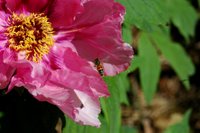 When photographing Peony flowers it is hard to not photograph a Honey Bee (Apis mellifera) or two. This is because Peonies produce copious amounts of pollen, and Bees collect pollen to take back to the hive, to feed to the larvae. The pollen is a source of protein and fat, which nourish the brood.
When photographing Peony flowers it is hard to not photograph a Honey Bee (Apis mellifera) or two. This is because Peonies produce copious amounts of pollen, and Bees collect pollen to take back to the hive, to feed to the larvae. The pollen is a source of protein and fat, which nourish the brood.Bees love Peonies -
Perhaps even more than I do.
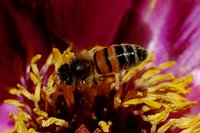 Several days ago I got this photo of a bee. It appeared that its wings were beating independently, not in "paired strokes" as we are familiar with in birds. Could this be true?
Several days ago I got this photo of a bee. It appeared that its wings were beating independently, not in "paired strokes" as we are familiar with in birds. Could this be true?If you double click on this image, you can just make out that the right wings are barely visible, blurred in a slightly forward-beating movement. The left wing is clearly visible.
Bee in flight over a Peony
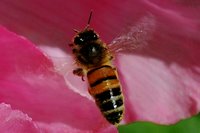 Again, if you look carefully at this photo, the right wing is clearly visible, but the left wing is blurred in a forward-movement (it is not reflecting the light in the same angle).
Again, if you look carefully at this photo, the right wing is clearly visible, but the left wing is blurred in a forward-movement (it is not reflecting the light in the same angle).Weird? I thought so.
Bee on Lavender flower.
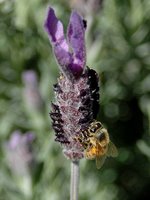 Today, there were lots of bees working the Italian Lavender bushes in my garden (bees love Lavender).
Today, there were lots of bees working the Italian Lavender bushes in my garden (bees love Lavender).So I set my camera on a fast speed, to see what I could find out.
 Lavenders do not appear to produce much pollen, so I assume they are attracting the Bees with nectar in their tiny flowers. The Lavender "flower" is a flower head, with numerous individual flowers clustered together.
Lavenders do not appear to produce much pollen, so I assume they are attracting the Bees with nectar in their tiny flowers. The Lavender "flower" is a flower head, with numerous individual flowers clustered together.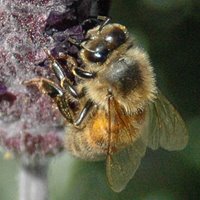 Bees are pretty hard to capture well on film. Indeed, I am sure that insect photography is truly the work of specialist photographers. But here are a few of my amateur shots.
Bees are pretty hard to capture well on film. Indeed, I am sure that insect photography is truly the work of specialist photographers. But here are a few of my amateur shots.The hairiness of bees is important, apparently, in creating a static charge on the bee, allowing pollen to stick to them - an important factor when transferring pollen from one flower to another.
Bee wings
beating independently!
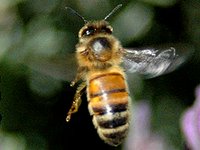 Gotcha!
Gotcha!The right wing is beating down and back (catching the light). The left wing is twisted (held at a different angle) as it moves forward and upward. This is described as a "figure of eight" pattern of wing beating.
Apparently, Bees beat and rotate their wings 240 times per second - hence the blurred images of their wings when in flight.

2 comments:
Wonderful shots. What patience!
Hi Denis, I suspect that the non-synchronized wingbeat is for manoeuvre. Your bees are in the process of slow traverse, rather than in free flight (straight line) and so the wings are acting appropriately. If you watch a bird under similar conditions you'll note independant positioning and geometry as well, to a lesser degree perhaps. And the birds have a tail to get involved in slow speed ballet too.
Post a Comment